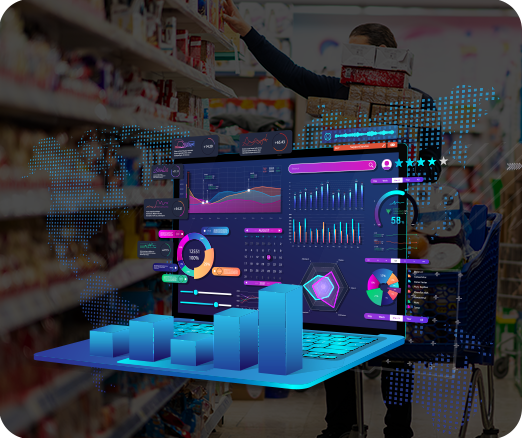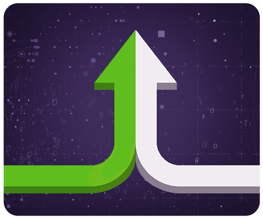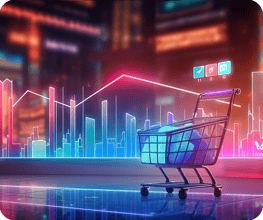
5 Benefits of Retail Data Analytics for CPG Companies
Table of Contents
If you’re in the consumer packaged goods (CPG) industry, you certainly don’t need us to tell you the entire consumer shopping experience has transformed immensely since 2020. E-commerce has become the preferred method of shopping, and although brick-and-mortar retail is not as popular as it once was, it’s not a lost cause. According to Google’s Zero Moment of Truth research, 70% of consumers research online before purchasing in-store, which makes paying attention to ALL retail data and retail analytics more important than ever.
CPG companies must monitor consumer buying behaviors, and it should not only be their data and business analytics departments regularly reviewing retail point-of-sale (POS) and inventory data.
Knowing how products sell both offline and online daily can help all company departments make more-informed decisions that significantly impact sales, revenue, and profitability. Understanding consumer behavior and how products live on retailers’ shelves helps improve the overall buying experience and positively impacts retailer relationships.
HOW RETAIL POS DATA ANALYTICS HELP CPG COMPANIES
When it comes to consumer packaged goods, there are many benefits to having eyes on important metrics like on-shelf availability, out-of-stocks, and replenishment rates. Here are five of the most compelling benefits of retail data analytics for CPGs.
Improve Demand Forecasting and Planning
Retail data analytics, based on granular, harmonized data, help CPG companies more clearly understand consumer buying patterns and trends. They can see which products are “flying off the shelves” and which aren’t; they can leverage item-level and store-level reporting to make effective plans to replenish low-stock products and reallocate products that aren’t moving as quickly. Supply chain teams can use this physical store and e-commerce performance data to plan how much product to get out the door and where it should go daily. In contrast, marketing and sales can use the data and price-point analyses to better forecast future strategies and promotions.
Achieve and Exceed Sales and Marketing Goals
Daily POS data can help reach sales and marketing goals when the teams know exactly how much product is moving, where, and why. It provides a more accurate measure of marketing and trade promotion ROI. Marketing and sales teams can use near real-time information to assess sell-through, giving them the ability to make critical and timely adjustments to campaign strategies. Knowing how and why products move can also enable marketing and sales to work more intelligently with retailers to optimize product assortments, in-store displays, and promotions.
Optimize New Product Launches
CPGs can see almost immediately how new product introductions (NPIs) perform by store, channel, and region to determine any next steps or promotional activity. Harmonized daily data versus latent syndicated data shows how well the NPI performed online and across all retailers. It also reveals if the new product caused an out-of-stock or is predicted to cause one and whether the NPI should be on promotion or temporarily removed and reevaluated. Teams don’t have to wait weeks or months to receive, translate, and leverage this information.
Personalize the Customer Experience
The granular data powers the insights that allow CPG companies to anticipate and respond to shifting buyer behavior which can enhance the overall customer experience. How a product performs online and on shelves tells companies a lot about buyer preferences, needs, and purchase behavior. Companies can use the POS data to analyze consumer behavior and tailor products and promotional offers to focus on shoppers’ specific needs or create personalized online shopping experiences that better engage the consumer and their needs.
Strengthen Retailer Partnerships
A huge benefit to having clean, accurate, granular POS data is that it helps build better partnerships with retailers. Sharing insights and leveraging data provided by day, store, and SKU displays a high level of expertise by CPG account management teams and creates strong trust with the retailer.
WHICH TEAMS BENEFIT FROM RELIABLE RETAIL DATA ANALYTICS?
It’s not hard to see that accurate and timely demand data and reporting can help CPG companies cut costs, streamline processes, invest wisely, and thrive. Here are the business groups most positively affected by data analytics:
- Sales teams can view accurate POS data by product category, retailer, store, channel, region, and SKU in near real-time to know exactly how each performs and why.
- Marketing teams can see lift by brand, product type, and SKU across retailers, regions, and online. They have a clear picture of NPI, marketing campaign, and trade promotion performance.
- Executive-level personnel can also gain deeper insight into how promotions and new product introductions are performing.
- Supply chain management can more accurately track and analyze inventory at the store, chain, or warehouse level and be more proactive in preventing inventory distortion and driving sell-through.
- Production teams can improve demand planning and optimize product production and shipping.
- CFOs can gain an understanding of what is “selling in” versus “selling through” to know where dollars should be spent to maximize ROI.
HOW CAN VELOCITY® HELP?
VELOCITY®, our industry-leading retail data analytics solution, provides CPG companies with accurate near real-time POS data so marketing and sales teams don’t have to collect, translate, and organize data and can increase their speed to insights. Harmonized data, integrated with third-party and internal data, allows business users to make informed and confident decisions together. With more timely insights, CPGs can improve profitability, which we believe is the biggest benefit.
If your company is ready to use and leverage daily retail point-of-sale data at the most granular level to generate actionable insights, drive profitable decisions, and accelerate your business growth, get in touch with us today.



